
Fly Fishing for Pompano – Pro Tips!
This article will thoroughly cover fly fishing for pompano. Pompano are a hard-fighting inshore saltwater species. They are similar in permit, although quite a bit smaller, averaging a couple of pounds. Pompano mostly feed by rooting along the bottom for crustaceans. Therefore, specific techniques will be required to catch pompano on fly.
Pompano are mostly found in the warmer states in the southeast part of the country. They are also found in sub tropical and temperate waters throughout the world. Pompano fight very hard for their size and are fantastic to eat!
My name is Capt Jim Klopfer and I am a fly fishing guide in Sarasota, Florida. While I seldom actually target pompano, they are a welcome interloper on inshore trips. Pompano are caught quite often when casting for trout and other species on the grass flats. I do specifically try for them on the bars in the passes.
Fly fishing for pompano

Pompano feed primarily on crustaceans on or near the bottom. Therefore, flies that mimic shrimp and crabs that are fished close to the bottom are more productive. Anglers fly fishing for pompano often encounter them in small schools or “pods”. They will be caught I bunches at times.
The top spots for fly fishing for pompano are shallow bars and grass flats. Most inlets and passes have long, extended sand bars. These are prime spots for pompano to cruise in search of crabs and shrimp. Shallow bars are also fairly plentiful in inshore bays as well. Depending on tide, bars in 2-4 feet of water seem to be the most productive.
Grass plats will also hold plenty of pompano. Water clarity will determine how deep grass with grow. In most cases, submerged grass beds in 3 feet to 8 feet are most productive. Pompano will raise up off the grass to take a fly. However, anglers fly fishing for pompano will do best working the fly just above the submerged vegetation.
Best tackle for fly fishing for pompano
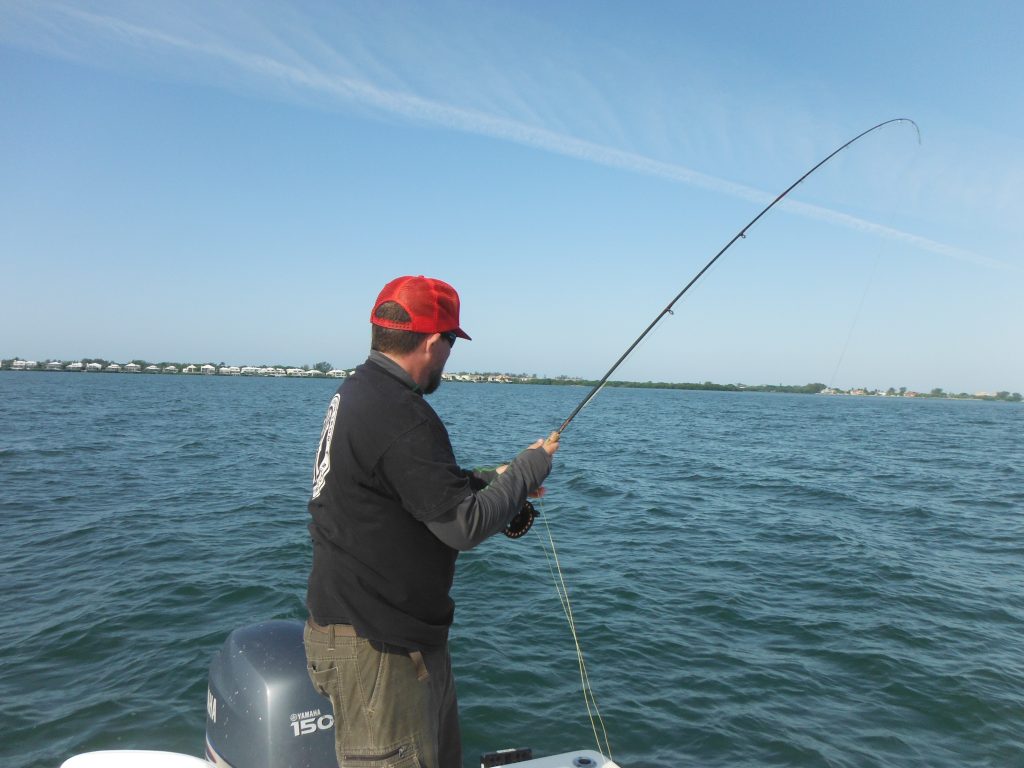
Tackle requirement for anglers fly fishing for pompano are pretty basic. The same inshore tackle used for speckled trout, Spanish mackerel, and other species will work fine. I use an 8wt outfit with an intermediate sink tip line the majority of time. Anglers can drop down to a 7wt or even a 6wt if desired, pompano are not large.
The primary challenge when fly fishing for pompano is getting the fly down. An intermediate sink tip line works well in most shallow water situations. Anglers can shorten up the leader if needed. I generally use a 9′ leader consisting of 5 feet of 40 pound butt section followed by 4 feet of 25 pound tippet.

Fly selection is uncomplicated as well. Any weighted pattern tied on a #1 to #4 hook will produce pompano. Clouser and Crystal Minnow patterns are tough to beat. My favorite colors are pink, chartreuse, white, and brown/root beer. I tie my pompano flies with heavy dumb bell eyes.
Pompano fly fishing techniques
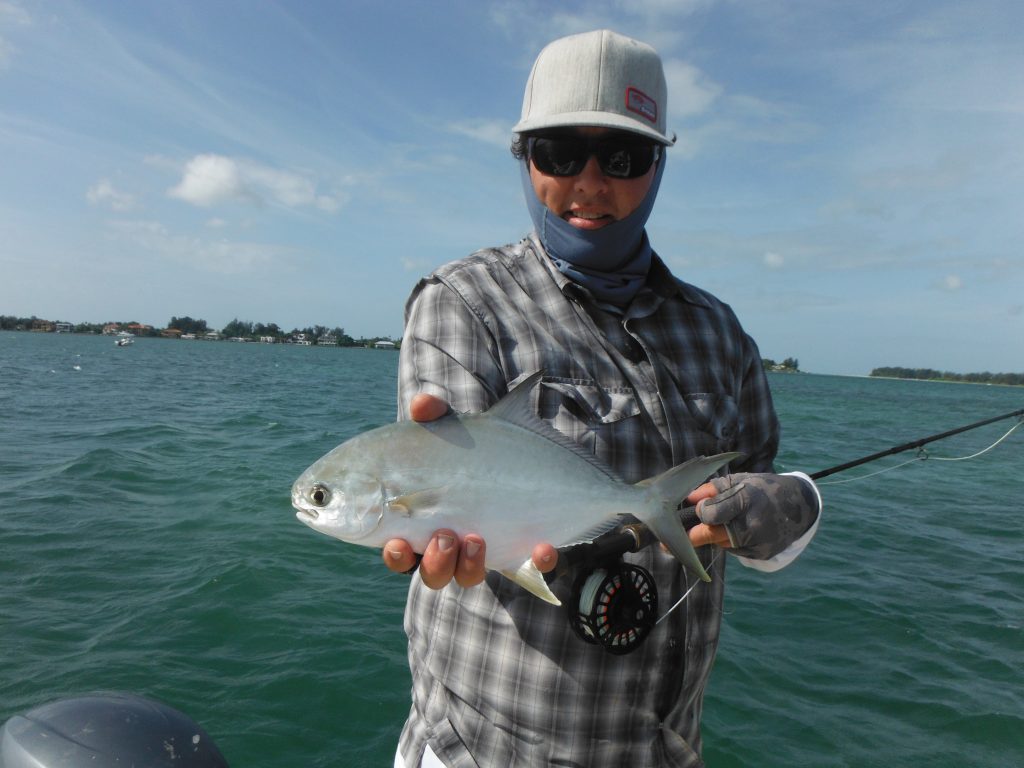
Fly fishing for pompano is not really different from chasing other species. The primary difference, or challenge, is to keep the fly on or just off the bottom. This is where pompano primarily feed. There are several different techniques that can be used to accomplish this.
A sinking line of some sort is mandatory, unless pompano are located in very shallow water. This does occur on occasion. However, pompano will more often be found in water three feet or deeper. An intermediate sink tip line works well in a variety of situations. Is what I use most of the time. I also prefer a clear sink tip, which allows for a shorter leader, if needed.
Anglers fishing deeper water can opt for a full sinking line. This works best in water ten feet or deeper, or if a strong current is present. Again, a shorter leader and weighted fly will keep the fly down. Sinking lines can be a bit more cumbersome, especially for novice fly anglers, but it is the best approach in deeper water.
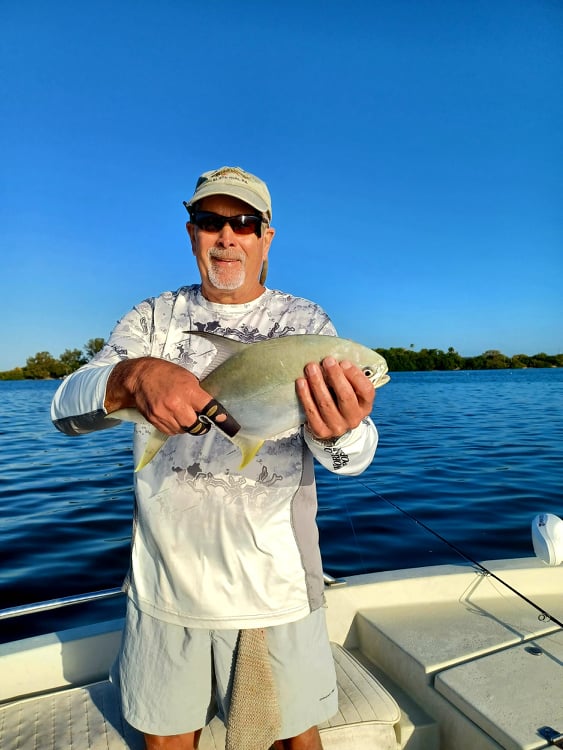
The technique for fly fishing for pompano is pretty straightforward. The fly is cast out ahead of the drifting boat and allowed to sink. It is then retrieved in using short, erratic strips. This best represents a freeing crab or shrimp. The take is usually pretty distinctive and easy to detect. A strip set is used to come tight on the fish. Larger pompano will have the angler on the reel, while smaller fish can be stripped in.
Locating pompano
Pompano tend to move around quite a bit. This not only occurs from day to day, but also our two hour depending on the tide. Pompano will often move in and out of inlets and passes with the tide feeding as they move along. They will also do the same thing on the deeper flats, constantly Rome in search of food.
Anglers can choose to either blind cast in search of fish or motor about and visually search them out. In shallow water, pompano can be seen cruising over the bottom if viewing conditions are good. These conditions would include clear water and sunlight with few clouds.
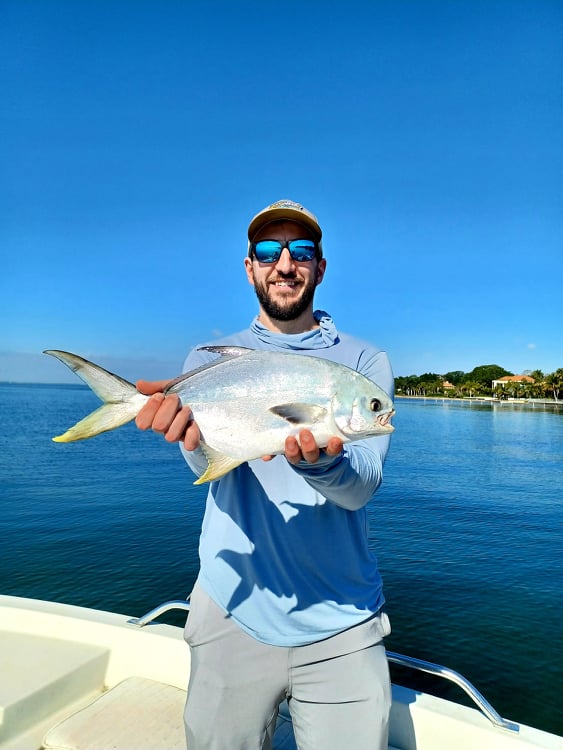
Pompano also exhibit a very unusual behavior. When startled, they will turn sideways and skip across the surface of the water in an attempt to fully. Anglers call this “skipping a pompano”. Therefore, anglers can idle about on a flat or bar in hopes of skipping pompano. Once they do, the best approach is to motor back around up current or upwind and then thoroughly fish that area.
Blind casting is really the only practical approach when fly fishing for pompano in deeper water. Experience is the best teacher along with local fishing reports. I personally do not spend very much time in one area if the bite is slow. The great aspects of fly fishing the deep grass for pompano is that anglers will invariably catch other species. Speckled trout, Spanish mackerel, bluefish, ladyfish, jacks, and other species will intercept a fly meant for a pompano. In most cases, anglers do not mind these interlopers!
Fly fishing the surf for pompano
Many anglers, both spin and fly, associate pompano with surf fishing. There is good reason for this as the surf is prime habitat for pompano. One of their favorite food sources is the mole crab, also known as a sand flea. These peanut sized crustaceans are found right in the surf line and are devoured by pompano and other species.
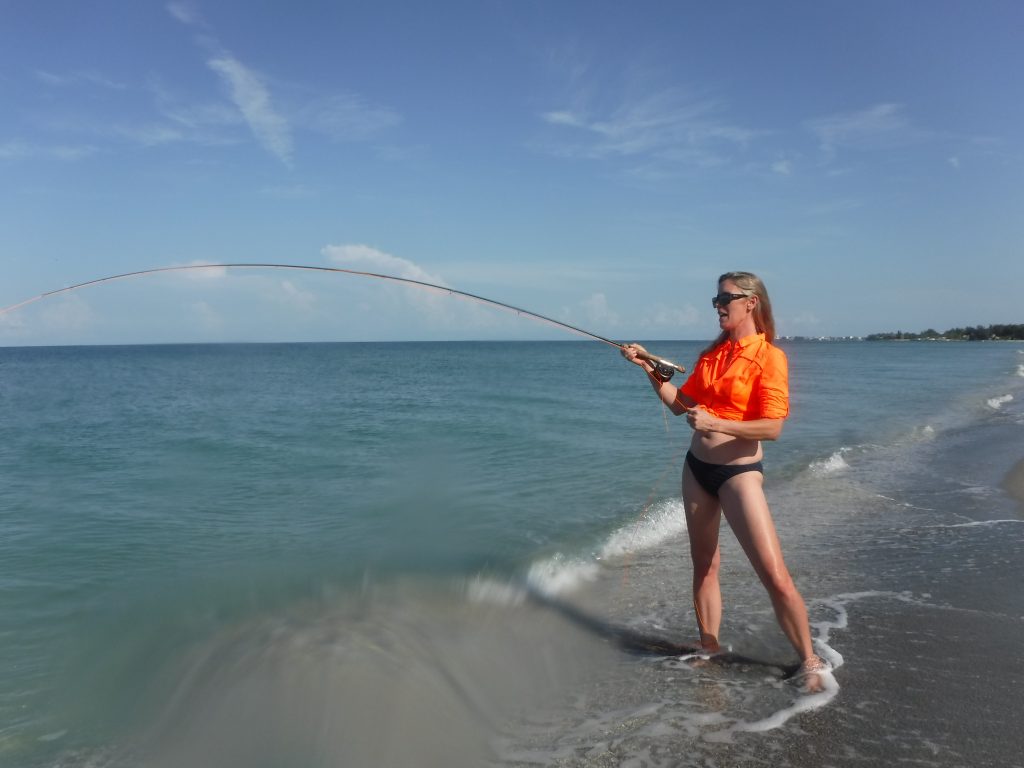
Fly fishing for pompano in the surf does present a few challenges. All along the Gulf of Mexico coast line, surf conditions tend to be milder than those in the Atlantic Ocean. It is certainly much easier to cast the fly, feel the take, and manage the line in a calm surf. In most instances, the pompano will be found in the first trough, within 20 feet of the shore line. In most cases, the angler does not even need to wade, but instead just cast from the sand.
The same technique that is used in a drifting boat works well when fly fishing for pompano from shore. The fly is cast out, allowed to sink close to the bottom, then retrieved in using short quick strips with a pause in between. Again, the biggest issue is dealing with the slack line, especially in a heavy surf. A stripping basket on the waist can be a necessity in this situation.
Pompano on the plate
Pompano are highly prized by anglers for several reasons. They are a beautiful fish that puts up a fight out of proportion to its modest size. However, for many anglers, myself included, Pompano are the ultimate fish to be enjoyed as a meal. While a proponent of catch and release, I do not have a problem with a client keeping a pompano or two for a tasty meal. However, they do not freeze well and only a fish or two should be kept to be enjoyed fresh.
In conclusion, this article on fly fishing for pompano will help anglers catch more of these incredibly hard fighting, beautiful, and tasty inshore saltwater game fish species!